Regalia of Thailand
The Royal Regalia of Thailand (Thai: เครื่องราชกกุธภัณฑ์ – Khrueang Racha Kakuthaphan) are the coronation regalia of the kings of Thailand, an expression of their power and dignity, and a symbol of their rule. They are now housed in the Pavilion of Regalia, Royal Decorations and Coins in the Grand Palace in Bangkok.
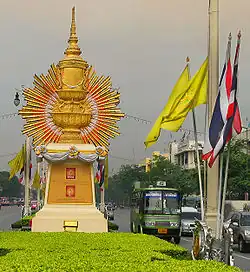
Coronation ceremonies
The royal regalia consists of 28 individual pieces, which are traditionally presented to the king during his coronation ceremonies. They are brought before the king in a festive procession by squires and chamberlains. While the court Brahmins recite sacred mantras, the king, seated on the "Bhadrapitha Throne," is first presented with "The Great Victor's Crown," which he places on his own head. The other regalia are then presented to him in turn. The king receives and examines them, and then they are placed on tables beside the throne.
The royal insignia
Shown in bold are the most important, the so-called “Five Royal Regalia” (Thai:เครื่องเบญจราชกกุธภัณฑ์ – Khrueang Bencharat Kakuthaphan; fans and fly whisks are combined):
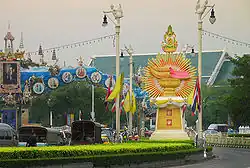
- The "Nine-Tiered White Umbrella" (Thai: พระนพปฎลมหาเศวตฉัตร – Phra Noppadon Maha Sa-wet Chat) is probably the oldest symbol of royal authority in Asia. It consists of several individual umbrellas arranged one above the other: five umbrellas for the Uparat, seven for the king before he is crowned, and nine for the king once he has achieved full sovereignty. George Groslier suggests that the historical origin of Siamese umbrellas lies in seventh-century Angkor.[1] Royal umbrellas of this type are also mentioned in the Jataka, as well as in the Mahāvaṃsa.
- The Great Crown of Victory (Thai: พระมหาพิชัยมงกุฏ – Phra Maha Phichai Mongkut) is probably the most unusual piece for a Western observer, as it does not correspond to the European idea of a crown.[2] The crown has a more conical shape, not that of a gem-studded diadem. It was made of gold in 1782 during the reign of King Phra Phutthayotfa Chulalok (Rama I) and enameled in some places in red and green. It is about 66 cm high and weighs 7.3 kg. The crown is topped with a large diamond, called the Maha Wichien Mani, which was only added by King Mongkut (Rama IV).[3]
- The Sword of Victory (Thai: พระแสงขรรค์ชัยศรี – Phra Saeng Khan Chaisi) was gifted to King Phra Phutthayotfa by Chao Phraya Apai Pubek of Cambodia in 1783.[2] Chao Phraya Apai Pubek supposedly found it in Tonlé Sap Lake. The hilt of the sword is 25 cm long, the blade 64.5 cm long. When sheathed, the sword measures 101 cm in total length and weighs 1.9 kg.
- The Royal Sandals (Thai: ฉลองพระบาทเชิงงอน – Chalong Phrabat Choeng Ngon) are made of gold and have slightly upward curves at the toes to protect the king's feet.[2] They are studded with diamonds and lined with red velvet. In ancient Siam, shoes were not worn; they were only appropriate for royalty. The custom was also unknown in ancient Cambodia, as shoes are nowhere to be found in the reliefs at Angkor Wat.[4] However, sandals (paduka) were worn by Rama, the hero of the Ramayana, and they are also mentioned in Jataka 406. In both places, the sandals represent absent royalty.
- The Fan (Thai: พัดวาลวิชนี – Phatwan-Wichani) came to Siam from Cambodia; similarly shaped fans are depicted on the reliefs at Angkor Wat: a palm leaf bent at a right angle to its stem.[2] In the hot countries of Asia, fans are traditionally associated with coolness and a sublime comfort befitting divine kings.
- The "Flying threads from the weaving of a Yak" (Thai: พระแส้หางจามรี – Phra Sae Hang Chamri) and
- The "Fly whisk made from the tail hair of a white elephant" (Thai: พระแส้หาง ช้างเผือก – Phra Sae Hang Chang Pueak)—both whisks are very ancient symbols.[2] They are already mentioned in the Puranas as royal props. The materials from which they are made appear to have been chosen for auspicious reasons.
- The "Royal Scepter" is probably symbolically equivalent to the Royal Staff. Although the scepter is an important insignia of European kings, no reference to it can be found in ancient Indian literature. H.G. Wells suggests that it corresponds to the thunderbolt (vajra) of the Hindu god Indra.[5]
- The Royal Staff (Thai: ธารพระกร – Than Phra Kon) is made from the wood of the Cassia fistula tree.[2] It is 118 cm long, has a knob at the top, and three points at the bottom. "It is intended to guide the king's steps on the path of justice and equality."[6]
- The "Personal Sword" was carried behind the Siamese kings on almost every occasion by the secretary of the royal household. It bears a resemblance to the sword seen by Zhou Daguan, the Chinese diplomat, when he visited the court at Angkor in 1296,[7] and possibly also to the "Phra Khan Jayasri," the Jayasri sword presented to King Si Inthrathit as an insignia by the Khmer ruler.[8]
- The "Brahmin Belt" is a traditional attribute of the Hindu god Shiva. Its presentation to the king is intended to symbolize the unity of the god with the king.[9]
- The “Shining Belt” and
- The "Belt of the Nine Gems" was formerly used as an amulet. The "Nine Gems" (diamond, ruby, emerald, yellow sapphire, garnet, black opal, moonstone, zircon, and chrysoberyl) represent nine planets; the auspicious stones "are said to endow the king with illustrious power and benevolence."[10]
- The “diamond ring” and
- The "Royal Ring" was also used as an amulet in earlier times. Similar jewelry was also worn by Khmer kings. Royal signet rings were already mentioned in the Jataka and the Ramayana.
- The "Golden Writing Tablet with Pen" is an important tool used during several coronation ceremonies. Approximately 22 days before the actual coronation, the tablet is "blessed" by Buddhist monks. The following day, at a time precisely determined by the royal astrologers, the royal scribe, under the supervision of the monks in the ubosot of Wat Phra Kaew, engraves all of the new king's titles and detailed addresses into the writing tablet. During this time, the court Brahmins blow their conch horns and the monks recite "Sutras of Victory." At the same time, the royal horoscope is engraved on a second golden writing tablet. Both tablets are then rolled up and placed in a golden tube, which is then placed in a rectangular golden container. The golden container is placed on a golden tray along with other insignia on the altar of Wat Phra Kaew, where they remain until the day of the coronation. Then the golden tablet in its containers is presented to the king along with the other insignia.
- In Mainland Southeast Asia, personal utensils were once generally considered insignia of nobility. Officials were given similar items by the king to mark their promotion. The king's personal utensils are, of course, made of a more precious metal—gold—and are set with precious stones, sometimes with red and green enamel decorations.
- The Eight Weapons of Independence appear to be of Siamese historical interest alone, and all likely refer to a specific historical moment – particularly in connection with King Naresuan, who is said to have killed the Crown Prince of Burma with the "Long-Hilted Sword" in 1593.[11] The bow is certainly the weapon with the oldest history, while the discus and trident are attributes of the Hindu gods Vishnu and Shiva, and are said to symbolize the king's connection with these two gods. It was also Naresuan who is said to have killed the leader of a Burmese raiding party with a single shot across the border river of the same name using the "Gun of Satong." These eight weapons, however, are said to have been reproductions made for the coronation of King Vajiravudh (Rama VI); the real weapons were probably lost when Ayutthaya fell in 1767.[12]
Impressions
To commemorate the 60th anniversary of King Bhumibol Adulyadej's (Rama IX) accession to the throne in 2006, Ratchadamnoen Boulevard in Bangkok's Phra Nakhon district was festively decorated. Various archways (exhibits), some of which spanned the entire width of the roadway, were set up on the green strip in the center. While the archways had historical, religious, or mythological themes ("The Naga," "Maha Chakri," "The Nine Gems," etc.), the exhibits depicted the Five Royal Insignia:
-
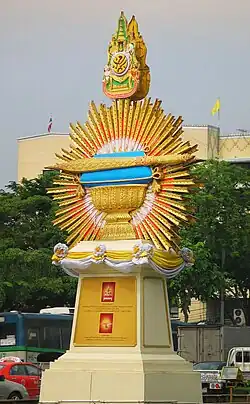 The Royal Sword
The Royal Sword -
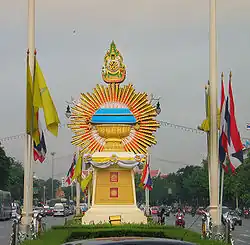 The Royal Staff
The Royal Staff -
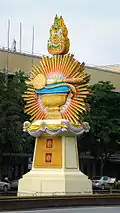 The Royal Fan and Fly Whisk
The Royal Fan and Fly Whisk -
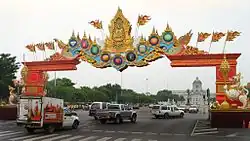 Archway "The Nine Gems"
Archway "The Nine Gems"
Literature
- H.G. Quadritch Wales: Siamese State Ceremonies. London 1931, Reprint by Curzon Press, Richmond 1992, ISBN 0-7007-0269-5
External links
- „Royal Regalia“
- Five Principal Royal Regalia for the Thai Monarch
- Wilfried Stevens: Die königlichen Insignien (German) thaipage.ch, 14. August 2013
References and notes
- ^ George Groslier: Recherches sur les Cambodgiens. Challamel, Paris 1921
- ^ a b c d e f "Royal Regalia: The Symbols of Kingship". Bangkok Post. 4 April 2019. Archived from the original on 8 Feb 2023. Retrieved 28 July 2025.
- ^ Siehe พระมหาพิชัยมงกุฎ in der thaisprachigen Wikipedia
- ^ Albert le Bonheur, Jaroslav Poncar: Of Gods, Kings and Men, Bas-reliefs of Angkor Wat and Bayon. Serindia Publications, London 1995, ISBN 0-906026-37-7
- ^ Wells: State Ceremonies, S. 100
- ^ Archived (Date missing) at chiangmai-chiangrai.com (Error: unknown archive URL) (englisch)
- ^ Siehe auch: Zhou Daguan in der englischsprachigen Wikipedia
- ^ Archived (Date missing) at aznforum.com (Error: unknown archive URL)
- ^ Wells: State Ceremonies, S. 101
- ^ Hochglanzbroschüre der BMA (Stadtverwaltung Bangkok) zum 60-jährigen Thronjubiläum von König Bhumibol Adulyadej im Jahr 2006
- ^ Siehe: Don Chedi
- ^ Wells: State Ceremonies, S. 106